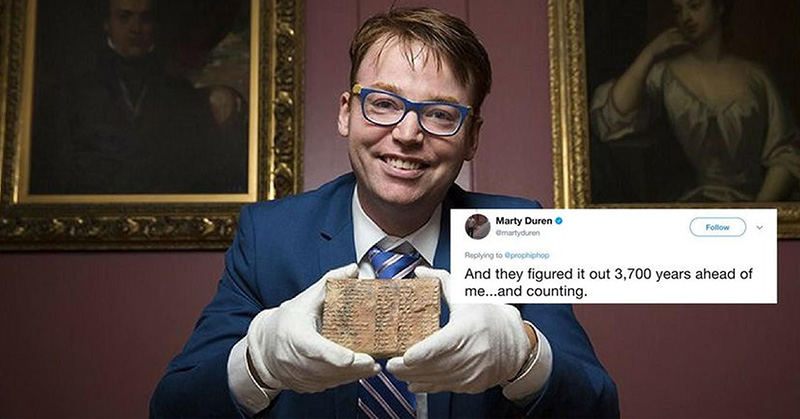Over the thousands of years that humans have existed on earth, we have come a long way as a species. Humans have made incredible advancements in science, math, medicine, and just about every other field you can think of. For this reason, it is very rare that our ancient ancestors teach us something new. An ancient Babylonian stone tablet has done exactly that. After puzzling researchers for decades, the tablet is teaching mathematicians a new type of trigonometry that could have practical applications today.
An Ancient Babylonian Stone Tablet
Scientists discovered the ancient tablet in the early 1900s in what is now Southern Iraq. Since then, however, researchers have not been able to determine what the tablet was for. Researchers from the University of New South Wales (UNSW) in Australia determined that the puzzling Babylonian stone tablet is a trigonometry table [1].
This makes the 3700-year-old tablet the world’s oldest and most accurate trigonometric table, meaning that the Babylonians, not the Greeks, were the first to study trigonometry. Trigonometry is the study of triangles.
The small tablet is known as Plimpton 322. It has four columns and fifteen rows of numbers written on it. Dr. Daniel Mansfield of the School of Mathematics and Statistics in the UNSW Faculty of Science says that the tablet has puzzled scientists for seventy years. They couldn’t figure out why ancient scribes generated and sorted the numbers, which was a very complex task.
“Our research reveals that Plimpton 322 describes the shapes of right-angle triangles using a novel kind of trigonometry based on ratios, not angles and circles. It is a fascinating mathematical work that demonstrates undoubted genius,” explained Dr. Mansfield [1].
He added that the tablet not only contains the world’s oldest trigonometric table, but it’s also the only one that’s completely accurate.
What Makes this Table More Accurate?
The reason the Babylonian stone tablet is more accurate than the systems we use today comes down to fractions. The tablet uses sexagesimal trigonometry, which means that all its numbers have a base of sixty. Today, the numbers we use have a base of ten.
Numbers with a base of ten only have two exact fractions- one half (or 0.5) and one fifth (0.2). This means that we have to do a lot of rounding in order to get whole numbers. For example, one dollar divided by three is thirty-three cents, with one cent left over. This lowers our accuracy when we’re dividing.
The Babylonians, however, counted with a base of sixty, the same way we tell time. This has many more exact fractions. For this reason, they were able to do a lot more exact division. For example, one hour divided by three is twenty minutes exactly.
With their system, the Babylonians were able to avoid any inexact numbers. For this reason, they could avoid any errors that occurred when multiplying those numbers [2].
The fifteen rows on the tablet represent the ratios for a series of right-angle triangles. They range from almost a square to almost a flat line. Through previous research, the researchers believe that the tablet originally had six columns and 38 rows [1].
Could This Change the Way We Do Math?
Researchers have always considered Greek astronomer Hipparchus to be the father of trigonometry. His “table of chords” on a circle was thought to be the oldest trigonometric table.
This ancient Babylonian table predates Hipparchus by more than one thousand years. UNSW Associate Professor Norman Wildberger says that this discovery opens up new possibilities for both modern mathematics research and mathematics education.
“With Plimpton 322 we see a simpler, more accurate trigonometry that has clear advantages over our own,” he said [1].
Many more of these Babylonian stone tablets exist, but Dr. Wildberger says that researchers have only studied a fraction of them.
“The mathematical world is only waking up to the fact that this ancient but very sophisticated mathematical culture has much to teach us.” [1]
Lastly, the researchers believe that Plimpton 322 was a powerful tool that could have been used to survey fields or make architectural calculations for the building of palaces, temples, and step pyramids.
The tablet is now in the rare book and manuscript library at Columbia University in New York.
Keep Reading: Boy Accidentally Finds 66-Million-Year-Old Dinosaur Eggs
Sources
- “Mathematical mystery of ancient Babylonian clay tablet solved.” Scimex. August 25, 2017.
- ” Plimpton 322 is Babylonian exact sexagesimal trigonometry.” Science Direct. Daniel F.Mansfield, N.J.Wildberger. November 2017.

